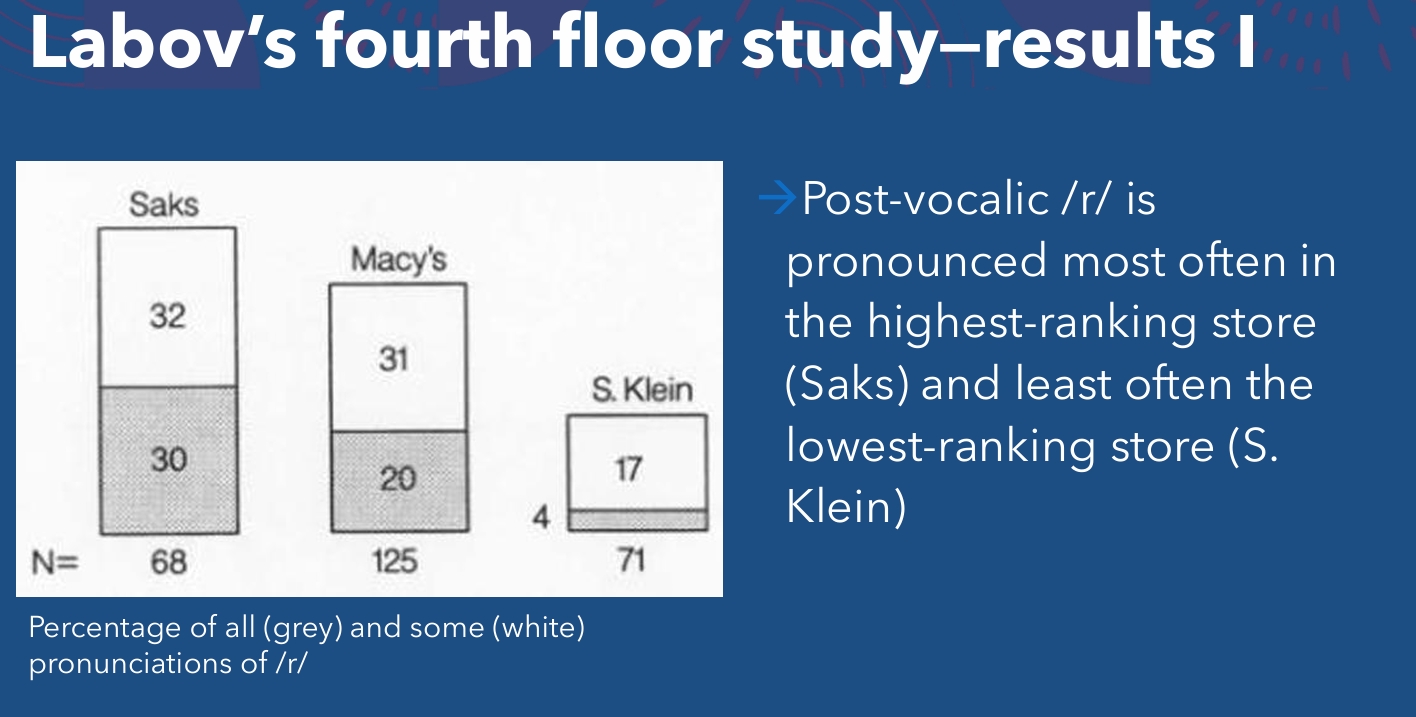Sociolinguistics
1/28
There's no tags or description
Looks like no tags are added yet.
Name | Mastery | Learn | Test | Matching | Spaced |
|---|
No study sessions yet.
29 Terms
Sociolinguistics 3 branches
Geographic (=dialectology) Sociolinguistic:
studies regional varities; replaced by sociological
Anthropological Sociolinguistics:
studies the connection between language —culture—thought
Sociological Sociolinguistics:
studies structure varities in language that includes social factors
studies regional varities (+comb: social factors)
Language variation
Variation in all level of langauge :
Spelling, Lexicon, Pragmatics.Phonectics, Syntax…
Independent variables (=non-ling.)
-Social variables that influence the choice of linguistic forms
e.g. Gender, age, style, region..
Assumption: Non-linguistic variables influence the
realisation of linguistic variables
Dependent variables (ling.)
alternative forms that are equvalent in meaning
e.g. that/which/zero — relativizer
Variety
most neutral term for form of a language
Standard
non-regional variety
Dialect
regional variety
Sociolect
social variety
Genderlect
gender variety
ethnolect
ethnic variety
jargon
professional variety
slang
informal variety
register
functional variety
accent
non-standard pronounciation

Dialect continua
fluent boundaries
local dialect speaker share mutual intelligibility with neighbouring local dialect speakters (across language boundaries)!
more distant local dialect speakers have a reduced or no mutual intelligibility (even same language)
applies only to local dialect level
E.g. The Romance languages (e.g., Spanish, French, Italian, Portuguese, Romanian) originated from Latin and form a well-known dialect continuum.
For example, in the Iberian Peninsula, Spanish and Portuguese dialects blend seamlessly near the border, with Galician (spoken in northwestern Spain) acting as a transitional variety between Portuguese and Spanish.
Isogloss
A line on a map marking the boundary between two region which differ with respect to a particular linguistc feature (e.g. pronouciation)
—> indicates diaclect boundaries
Dialect map
visual representation of the geographical distribution of dialects within a language. It shows where specific dialects are spoken and how linguistic features vary across regions
Explain the relevance and problems of the focus on NORMs in early dialectology
Non-mobile Older Rural Man (= most authentic speaker)
Stability: least influence+long time speaker
historical development of language , perserved features that disappeared mobility/urban
Problems:
Gender/Age Bias —> understanding for linguistic variation wrong!
Language is dynamic
static and outdated viwe of dialects
Social factors ignored
Name three differences between traditional dialectology and more recent variationist approaches to regional sociolinguistics
Traditional dialectology:
Focus on rural dialect
Contrast rural dialect vs. standard
Data: surveys
Variationist sociolinguistics:
Focus broad varities of Englisch
interaction geographical + social features effecting language
Summarise Kachru’s three circles model and provide examples for each circle
Inner circle: english a native language
Outer circle: English used for official purposes
Expanding circle: English as a foreign language ➔Fluent boundaries, situation often more complex
Briefly summarise the three waves of variationist sociolinguistics and the differences between them
1st wave: focus on correlation of dependent and independent variables
2nd wave: builds on 1st includes ethnographic info about social factors and speaker agency
3rd wave: how language used to construct social identities
Briefly summarise Labov’s department store study (= fourth floor study
How does the pronunciation of post-vocalic /r/ vary across different speakers in New York City?
• Background:
➢General American Standard English: Rhotic (/r/ pronounced)
➢New York City: became r-less in the 19th century but re-introduction of /r/ pronunciation after World War II as a “change from above”
➢Assumed variation according to: social class, style (formality, attention), position (word-medial vs. word-final)
• Dependent variable: pronunciation of post-vocalic /r/ in all four positions
• Independent variable: store and social information about respondent

Pronounication of “r” influenced by:
social class; Expl-style ; -linguistic constraints;
→/r/ is pronounced most often in the highest ranking store (Saks) and least often the lowest ranking store (S. Klein) →/r/ is pronounced more often in careful speech →Word-final /r/ is pronounced more often than word-medial /r/

Explain low-density, high-density and multiplex links
Low density: Members that know central member don´t know each other
High demsity: Every member of network know all
Multipley link: Members are linked through co-existing types of ties
Explain the concepts of low-density, high-density and multiplex networks and their relevance for sociolinguistics
Low density:
-greater linguistic variation —> diffusion linguistic features across communities —> innovation/change
High density:
-reinforce linguistic norms + resist change —> group identity (perservation)
Multiplex link:
-complex linguistic behavior —> e.g. code-switching…
Explain “change from above”
Introduced by dominat social class/group
Full public awarness
Often borrowing with higher prestige
Explain “change from below” (dominat type of change)
Introduced by any social class (not observed for higher social group)
Below level of social awarness until change is almost complete
1st appears in vernacular
Explain the concepts overt / covert prestige
Overt Prestige:
-Standard language ; “correct” language use
-can promote “change from above”
Covert Prestige:
-language valued by specific group
-vernacular forms
Important creating group identity
-can promote “change from below”
Communitiy of Practice
Mutual engagement
Joint enterprise
Shared linguistic repertoire
e.g. New bakers